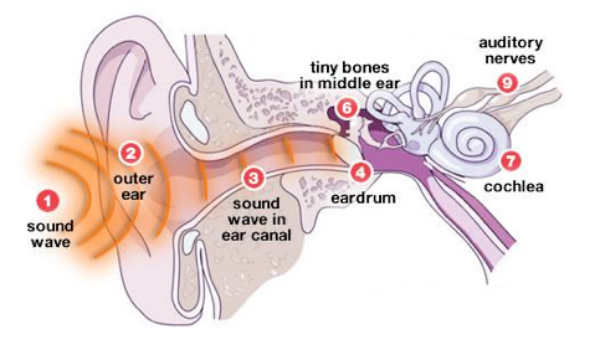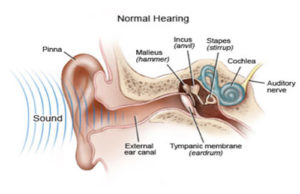- Pediatric Hearing Loss: Overview - September 19, 2016
- The Mechanism of Hearing: A General Overview - September 19, 2016
- Cochlear Implant: An Overview - September 19, 2016

- Risks of Surgery for Surfer’s Ear - October 26, 2017
- The Dangers of Untreated Exostosis / Surfer’s Ear - October 26, 2017
- Surfer’s Ear Treatment: Chisel vs Drill - October 26, 2017
The process of hearing has evolved over time to provide critical sensory information that is essential to our everyday lives. Like other sensory organs, the ear is responsible for gathering data from the environment and translating it into a form that our brains can understand. In hearing, this process begins with sound waves.

Sound waves are in essence vibrations carried through the air. The process in which our brains interpret those vibrations to sound can be divided into three measures: collecting the vibrations, converting those vibrations into mechanical energy, and relaying each as an electrical impulse to be interpreted as sound by the brain. Similarly, the ear itself can be divided into three distinct anatomical areas that are responsible for these distinct processes:
- Outer Ear
Sound waves are funneled into the ear via the auricle and through the external auditory canal to the tympanic membrane (eardrum) where the vibrations are then converted into mechanical energy.
- Middle Ear
The tympanic membrane is attached to the first in a chain of three small bones (malleus, incus, and stapes) known as the ossicular chain. The three bones propel one another sequentially, ultimately striking the oval window.
- Inner Ear
The primary component of the inner ear in the process of interpreting sound is the cochlea, a coiled chamber of fluid. The cochlea’s oval window is the membranous barrier between the middle and inner ear. When the last bone in the middle ear strikes the oval window, the resonance is carried through fluid called perilymph. The bottom layer of the cochlea is carpeted by a layer of microscopic hair cells, each stimulated by specific frequencies, or pitches, of sound waves/vibrations. Once stimulated by the movement of the perilymph fluid, they relay that information to the brain via the auditory nerve to be interpreted in the brain as sound.
All of the steps mentioned above, are critical to the process of hearing. Because of this relationship, damage or a defect in any of these structures can lead to hearing loss.
Some Causes of Hearing Loss
- Head trauma
- Advanced age (Presbycusis)
- Physiological congenital defects
- Prolonged exposure to loud noises
- Ototoxic medications (i.e. aspirin, certain antibiotics, and chemotherapy)
- Autoimmune diseases
- Ménière’s disease
- Ear infections
- Tumors of the inner ear and cochlear nerve (acoustic neuroma)
Issues with hearing should be promptly evaluated by a qualified medical specialist known as an otologist. Otology is a subspecialty of otolaryngology (ENT). These physicians are experts at evaluating and diagnosing conditions of hearing and balance.
To learn more about hearing and balance, please visit: www.ohni.org.



